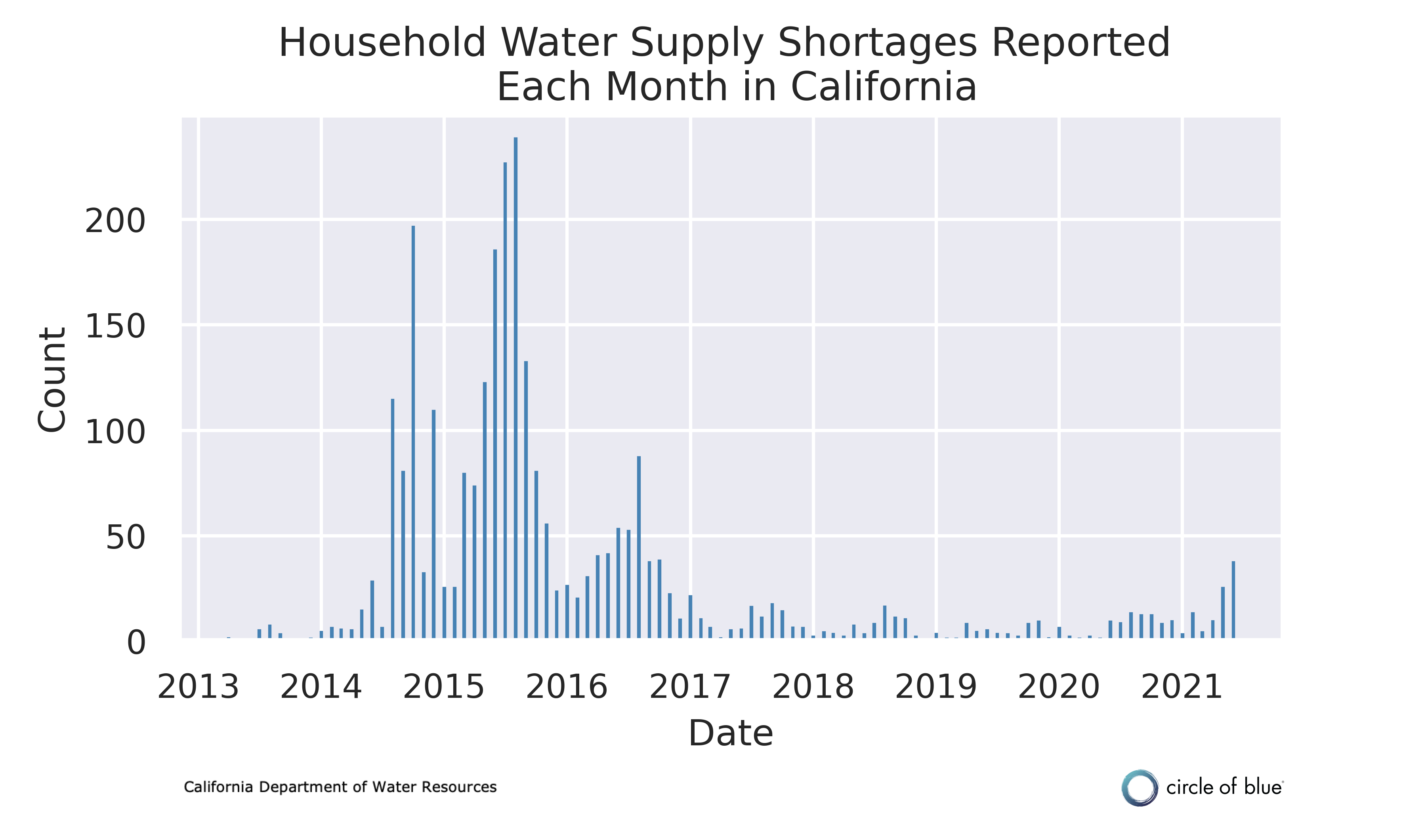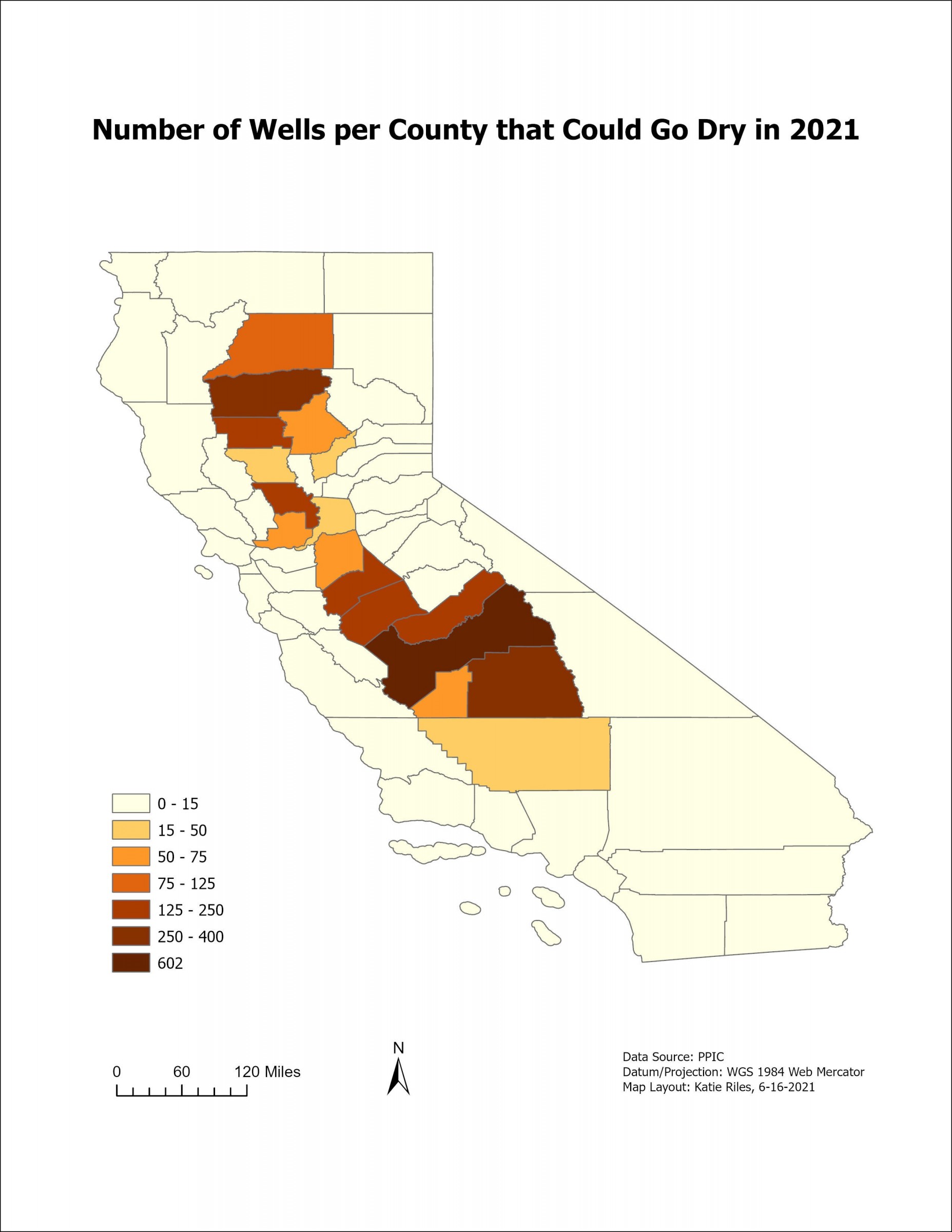Government agencies and nonprofit groups are preparing for difficult months ahead.

Guillermina Andrade (left) and Vicente Tapia filled barrels from a water depot outside the East Porterville, California, fire station. When this photo was taken, in April 2015, the well at their nearby home had been dry for 18 months and they visited the depot twice a week for water. Photo © J. Carl Ganter / Circle of Blue
- In this blistering year in California drinking water wells are going dry in increasing numbers, rekindling memories of the historic drought of 2012 to 2016.
- California is not yet to that level of emergency. But because the trend lines do not look promising, government agencies and nonprofit groups are preparing for a difficult summer in which thousands of wells could fail.
- However, experts and officials say that government agencies and nonprofit groups are better equipped to respond this time around. They have more data, sharper insights, and the wounds of the previous drought are still fresh.
- PPIC estimates that offsetting the impacts to homeowners — by deepening their wells, providing temporary bottled water and tanks, and drilling new wells — would cost only tens of millions of dollars and also maintain farm employment.
By Brett Walton, Circle of Blue – June 17, 2021
On Memorial Day, while many Californians were celebrating the unofficial start to summer, the owners of the home off of County Road 200 were contemplating a loss.
That day, the homeowners in northern Glenn County submitted an anonymous report to a state database indicating that their drinking water well was on the verge of sputtering out. The flow of the shallow well, only 75 feet deep, had slowed to a trickle. The property, located outside the town of Orland, is in an agricultural valley some 100 miles north of Sacramento, an area covered by almond, walnut, and olive orchards.
The failing well was not an isolated case — and not a quick fix either, as the incident report went on to recount:
“Everyone around us and neighbors are having the same problems and with our water table being so low we will have to drill the well deeper but the wait list in Orland and Glenn County is months out and we cannot afford that cost.” Another incident report from Orland this month estimated the cost of drilling a new well at $20,000.
In this blistering year in California drinking water wells are going dry in increasing numbers, rekindling memories of the historic drought of 2012 to 2016, when more than 2,600 wells across the state stopped producing water. So many wells went dry in 2014 in the town of East Porterville that Tulare County supplied portable public showers.
California is not yet to that level of emergency. A state database for household water supply issues received 38 dry well reports in the first 12 days of June, the most for any month since October 2016. But because the trend lines do not look promising, government agencies and nonprofit groups are preparing for a difficult summer in which thousands of wells could fail.
A rough estimate from the Public Policy Institute of California found that if groundwater levels decline at the same rate as in the last drought, about 2,700 wells could go dry in 2021. The problem is growing so rapidly in Glenn County not only because of spectacular aridity in recent months but because the area hadn’t truly recovered from previous dry years.
“We have lower groundwater levels than before,” Amy Travis, deputy director of the Glenn County Office of Emergency Services, told Circle of Blue. “We’re seeing impacts much more quickly.”
Similar conditions have taken hold across the state, which just experienced its third-driest winter on record and is currently baking in temperatures that exceed 100 degrees Fahrenheit. Major reservoirs are less than half their historical average for mid-June, and the state has begun cutting off surface water deliveries to farmers. Eighty-five percent of California — and the entirety of the Sacramento and San Joaquin valleys — is in severe or exceptional drought, the two worst U.S. Drought Monitor categories. Though the San Joaquin Valley was the epicenter of the dry well crisis in the last drought, the effects are being felt this time in northern Sacramento Valley counties like Glenn.

Reports of household water supply shortages submitted to a state database each month. Most of the reports are for dry wells. Graphic created by Katie Riles/Circle of Blue
Experts and officials interviewed for this story felt that government agencies and nonprofit groups are better equipped to respond this time around. They have more data, sharper insights, and the wounds of the previous drought are still fresh.
“We definitely have more resources and knowing the key players allows us to collaborate better and faster,” Tami McVay of the nonprofit group Self-Help Enterprises wrote to Circle of Blue. Visalia-based Self-Help Enterprises assists homeowners when their wells go dry.
“I think there’s better awareness of what we need to be looking for and what we’re evaluating,” Ken Austin, Fresno County Office of Emergency Services manager, told Circle of Blue. There’s more awareness of funding resources and more data is being collected, he said. “I think we’re better off just because we’ve been through it.”
The consensus view is that communication and outreach are the foundation of the response. And that early action is superior to post-failure reactions.
“We have lower groundwater levels than before, We’re seeing impacts much more quickly.” — Amy Travis, deputy director of the Glenn County Office of Emergency Services. Click To TweetCounties, not the state, regulate new wells. But counties often don’t have the capacity to carry out emergency work. Instead, they function as an intermediary, connecting people in need with nonprofit groups that can assist with state and federal grants. But agencies can’t provide help if they don’t know who needs it, said Sarge Green, a consultant to the Partnership for the San Joaquin Valley, a forum for regional collaboration. That’s why tools like the state’s reporting system are important.
The Partnership, which held its first drought working group meeting this week, is taking the lead on coordinating a response in the eight counties of the San Joaquin Valley. It is trying to reach people who might be leery of government intervention.
“Really it’s about making it an easy, smooth, non-confrontational process where they can get the help they need,” Green told Circle of Blue.
In the last drought, the state funded a program that provided water tanks to households with dry wells. Trucks visited homes every week or two to refill the tanks. Austin said that currently no tank program has been established, though Gov. Gavin Newsom did propose $27 million in his budget request to respond to drinking water emergencies in the drought.
Though nonprofits like Self-Help Enterprises coordinate tank programs and bottled water deliveries for homes with dry wells, Austin said that he doesn’t believe local governments would do the same if the state does not come through this year. “There’s a lot of things still to be decided about what the government’s responsibility is in addressing all the needs,” Austin said.

The Public Policy Institute of California estimated that about 2,700 wells could go dry in the Sacramento and San Joaquin valleys this year if groundwater level decline is similar to that in the 2012-16 drought. Graphic by Katie Riles/Circle of Blue
Could a state groundwater regulation law passed in 2014 prevent farmers who are cut off from surface water from pumping so much groundwater that household wells go dry? In theory, yes, says Ellen Hanak of the Public Policy Institute of California. But local regulatory bodies are newly formed and might not have the data or power to target restrictions. Then there are the costs and benefits. The cost of pumping restrictions could result in hundreds of millions or billions of dollars in lost farm output. PPIC estimates that offsetting the impacts to homeowners — by deepening their wells, providing temporary bottled water and tanks, and drilling new wells — would cost only tens of millions of dollars and also maintain farm employment.
A drawback is that well drillers already have so much demand that there are wait lists. In the last drought, California officials alleviated this pressure by inviting licensed drillers from other states.
For people like the homeowners off of County Road 200, stopgap solutions will have to make due in the interim. The town of Orland, for instance, is offering bulk water delivered via tanker truck. People with dry wells pay $10 per 1,000 gallons, plus a delivery fee set by the trucking companies.
Even that might be a temporary arrangement. Pete Carr, the town manager, told Circle of Blue that he hopes another town in the southern part of the county, where fewer wells have gone dry, will be willing to take on the responsibility of providing bulk water. Most of the dry wells in Glenn County are around Orland, and Carr doesn’t want to put Orland’s six community wells at risk from increased demand.
“We don’t want to hasten the demise of our wells,” Carr said.
Brett writes about agriculture, energy, infrastructure, and the politics and economics of water in the United States. He also writes the Federal Water Tap, Circle of Blue’s weekly digest of U.S. government water news. He is the winner of two Society of Environmental Journalists reporting awards, one of the top honors in American environmental journalism: first place for explanatory reporting for a series on septic system pollution in the United States(2016) and third place for beat reporting in a small market (2014). He received the Sierra Club’s Distinguished Service Award in 2018. Brett lives in Seattle, where he hikes the mountains and bakes pies. Contact Brett Walton



